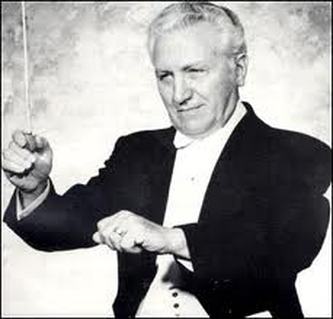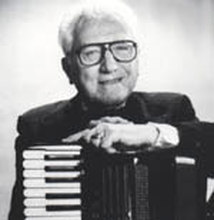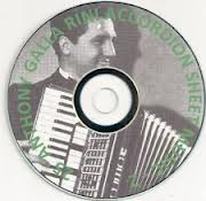Anthony Galla-Rini (1904 - 2006)
|
Anthony Galla-Rini was born in Manchester, Connecticut, January 18th 1904 as the son of an Italian immigrant family.
At the age of four his father taught him how to play the cornet and at the age of only seven he was forced to leave school and to join his father and two sisters in Cheyenne, in order to play with them in a vaudeville act. Galla-Rini would perform on this circuit for the next twenty years, touring the United States with his family and playing with such vaudeville stars as Mae West and the Marx Brothers. At the same time Anthony Galla-Rini would learn to play all of the woodwind and brass instruments, he studied harmony, counterpoint and operatic and symphonic conducting. His accorden playing became more important to the family-act once his two sisters had left it, and it was at this time that he realised the versatility of the instrument and saw its possibilities. In 1924 Anthony also left his father's vaudeville act, due to disputes over salary and he joined his sisters. With them he formed a new act, that lasted till 1932. |
The vaudeville acts ended with the advent of motion pictures with sound and all artists had to go for another profession. Galla-Rini settled in San Fransisco and became close to Pasqualle Petromilli, co-owner of the Guirini accordeon factory and subequently married his daughter Dina. He opened an accordeon studio and established himself as a teacher, he published his arrangements, conducted seminars and organized accordeon orchestras, before moving to Eagle Rock, California. About three years later Galla-Rini would move from California to New York City to be closer to the publishing houses. Eventually he was writing for more than thirty music publishing companies.
|
It was Galla-Rini's dream to elevate the status of the accordeon to that of a classical instrument. He was one of the founding members of the American Accordeonists' Association (AAA), in 1938 in New York City and also founded the International Accordeon Teachers' Guild in 1941 in Chicago. Throughout his career his was President Emeritus of that society and he was also Vice-Presicent of the Confédération Internationale des Accordéonistes (CIA), a member of the United Nations' International Music Council (IMC).
In 1941 Galla-Rini composed his first major work, Accordeon Concerto in G minor no 1, scoring the orchestral part as well as the solo part. It got its premiere with the Oklahoma Symphonical Orchestra and Anthony Galla-Rini playing as soloist. This concerto has been performed in the United States, England, Finland, Norway and Canada. Galla-Rini returned to California in 1942. He started teaching accordeon again and joined a rumba band playing at the Trocadero on Sunset Boulevard. This led to invitations to record sound-tracks for the film industrie. He played in many films, such as The gunfighter, High Noon and Rhapsody in Blue. During the next years he went on tour, performing in the United States, England, Scotland, Norway and Sweden, taking his family with him. |
|
In 1951 he represented the International Accordeon Teachers' guild (ATG) at the Confédération Internationale des Accordéonistes (CIA), which resulted in the CIA accepting the ATG as a member of the organization. Seven years later, in 1958 and also the year after he performed in Carnegie Hall in NewYork, one of the most prominent and prestigious concert halls, as a guest artist.
In 1968 Dina Galla-Rini died and three years later Anthony married Dolly Cortella. He was married to her untill she died at the age of 101. In 1975 the president of Italy conferred on him the title of Cavalier of the Star of Solidarity, in recognition of his efforts towards strenghtening the cultural bonds between the Italian and American people and for his interest in the development of the Italian accordion in America. |
In 1976 he composed "Accordion Concerto no 2 in E minor", three movements, for free bass accordeon. In 1983 he composed "Sonata in D minor" for accordeon, also in three movements.
From 1990 on, Galla-Rini started to give accordeon camps every summer, where he gave workshops and conducted ensemble work. In 2003 he was inducted in the ATG Hall of Fame.Anthony Galla-Rini died in 2006 of a heart attack in a hospital in Corona, CA, at the age of 102.
For the accordeon, Galla-Rini has been a very important person in the western world: he did a lot of pioneering efforts for standardizing the stradella system, notating exact pitch of all the five sets of reeds in the left hand, notating the left hand in bass clef and the logical choice and placement of the left and right hand registers. He was a great composer and he has arranged houndreds of transcriptions, both classical and modern, from orchestral works for accordeon ensembles, orchestras and soloists. His advanced arrangements are challenging sometimes, but worth the effort.
Source: accordions.com, accordionusa.com, Wikipedia
From 1990 on, Galla-Rini started to give accordeon camps every summer, where he gave workshops and conducted ensemble work. In 2003 he was inducted in the ATG Hall of Fame.Anthony Galla-Rini died in 2006 of a heart attack in a hospital in Corona, CA, at the age of 102.
For the accordeon, Galla-Rini has been a very important person in the western world: he did a lot of pioneering efforts for standardizing the stradella system, notating exact pitch of all the five sets of reeds in the left hand, notating the left hand in bass clef and the logical choice and placement of the left and right hand registers. He was a great composer and he has arranged houndreds of transcriptions, both classical and modern, from orchestral works for accordeon ensembles, orchestras and soloists. His advanced arrangements are challenging sometimes, but worth the effort.
Source: accordions.com, accordionusa.com, Wikipedia
|
Works:
1941: Accordeon Concerto no 1 in G minor (three movements)
1983: Sonata in D minor for accordeon (three movements) Arr. Jesu, Joy of man's desiring, Bach |




